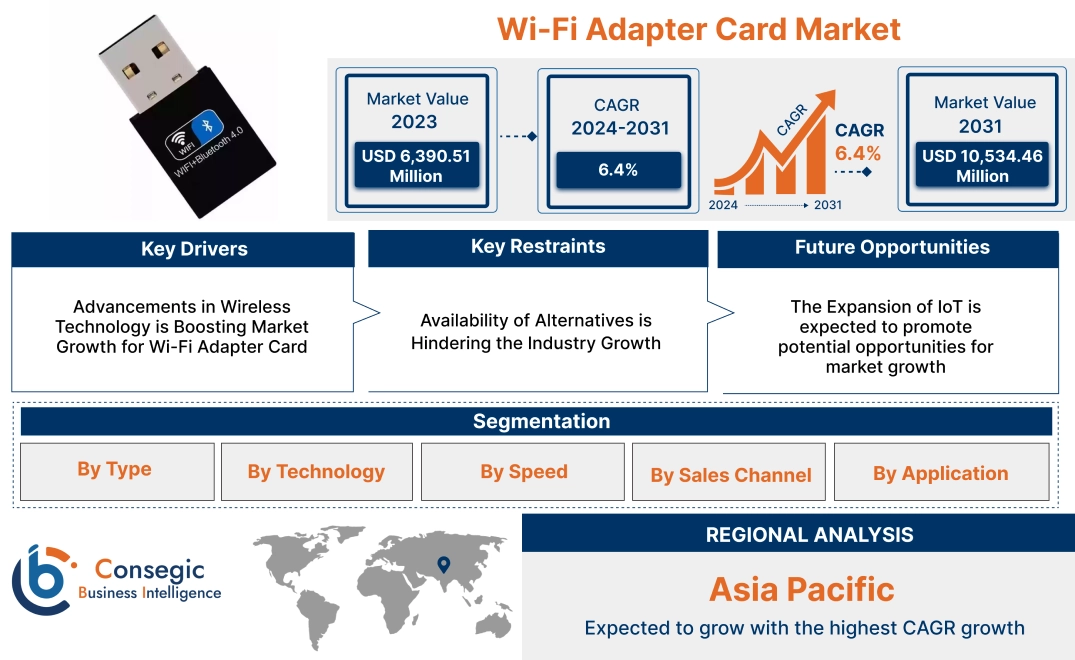Wi-Fi Adapter Card Market Size:
The Wi-Fi Adapter Card Market size is estimated to reach over USD 10,534.46 Million by 2031 from a value of USD 6,390.51 Million in 2023 and is projected to grow by USD 6,688.70 Million in 2024, growing at a CAGR of 6.4% from 2024 to 2031.
Wi-Fi Adapter Card Market Scope & Overview:
A Wi-Fi adapter card is a hardware component designed to enable devices to connect to wireless networks. These adapters allow computers and other devices to access the internet and interact with other devices over a Wi-Fi network without the need for physical cables. The wireless cards operate by using radio frequency signals to transmit and receive data. Additionally, these adapters offer a wide range of benefits including mobility, flexibility, scalability, and convenience in the connection. The aforementioned benefits of Wi-fi adapters are major determinants for increasing their deployment in residential, commercial, gaming, and various industries.
Wi-Fi Adapter Card Market Insights:
Wi-Fi Adapter Card Market Dynamics - (DRO) :
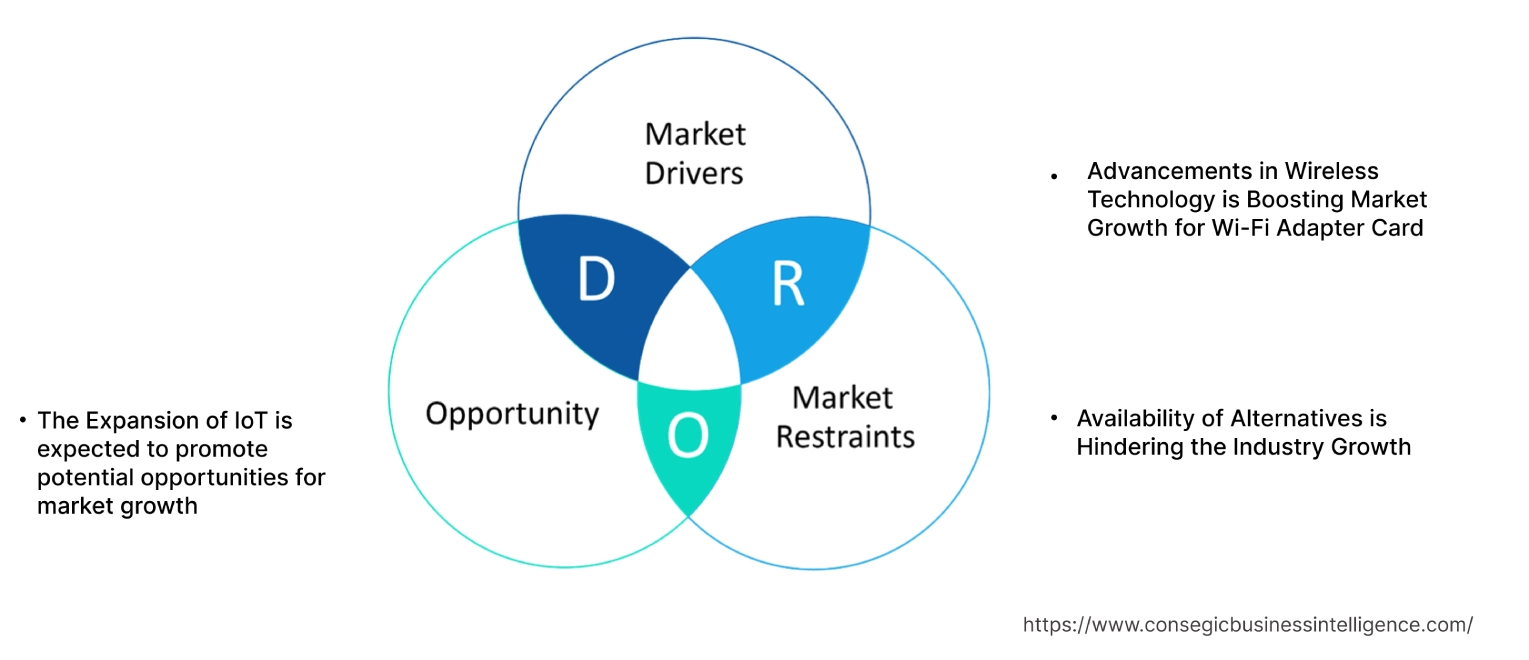
Key Drivers:
Advancements in Wireless Technology is Boosting Market Growth for Wi-Fi Adapter Card
The rising adoption of wireless technology is a significant driver in the Wi-Fi card adapter market. Advancements in new wireless standards including Wi-Fi 6 and Wi-Fi 6 offer faster speed, and better performance in high-density environments, making them ideal for a range of applications from gaming to streaming to IoT and smart devices. As more devices become wirelessly connected, reliance on traditional wire networks is diminishing, leading to a greater need for efficient solutions. This trend is particularly evident in both consumer and enterprise sectors, where mobility and flexibility are increasingly prioritized. Additionally, as the demand is increasing for wireless connection in households and businesses, the adoption of these advanced technologies has increased.
- In November 2022, TP-Link launched a Wi-Fi 7 networking solution for homes and businesses, including the Archer BE800 and Deco BE95 mesh system, designed to deliver ultra-fast speed and handle multiple devices efficiently.
Therefore, the adoption of these advanced technologies fuels the need for upgraded adapters driving the Wi-Fi adapter card market growth.
Key Restraints :
Availability of Alternatives is Hindering the Industry Growth
Availability of alternatives including built-in Wi-Fi modules in modern devices, USB Wi-Fi adapters, ethernet cables, 5G network, powerline networking, and others. These alternatives offer greater convenience, improved performance, and enhanced coverage, leading consumers to favor them over traditional Wi-Fi adapter cards. Additionally, advancements in these technologies and integrated networking solutions provide users with multiple choices that offer comparable, superior performance.
- For instance, the use of ethernet cables for stable and high-speed internet connections remains a popular alternative to Wi-Fi adapters, especially in educational, healthcare, and office environments where wired connections are preferred for their reliability and performance.
Hence, the availability of alternatives is significantly restraining the Wi-Fi adapter card market.
Future Opportunities :
The Expansion of IoT is expected to promote potential opportunities for market growth
As more devices become connected to the internet and each other, the need for reliable, high-speed wireless connectivity grows exponentially. Wi-Fi adapter cards are crucial in enabling these devices to interact and control seamlessly. Additionally, the proliferation of smart devices including thermostats, security cameras, lighting systems, smart home appliances, and automated systems has created a massive need for stable and efficient Wi-Fi connections.
- In June 2022, Samsung enhanced SmartThings Hub to support a wide range of IoT devices including smart home appliances and security systems. The Hub's built-in Wi-Fi card adapter was upgraded to handle increased data traffic, allowing users to manage smart devices efficiently through a single network.
Thus, the growth of IoT devices creates dynamic opportunities for the global Wi-Fi adapter card market opportunities.
Wi-Fi Adapter Card Market Segmental Analysis :
By Type:
Based on type the market is segmented into Internal Wi fi adapter and External Wi fi adapter.
Trends in the type:
- Internal adapters are increasingly incorporating the latest Wi-Fi 6 and Wi-Fi 6E to provide higher speeds and better performance.
- External Adapters are popular for their ease of installation, requiring no internal modification and providing immediate connectivity improvements.
The internal Wi-Fi adapter accounted for the largest revenue share in the year 2023 and is anticipated to register the fastest CAGR during the forecast period.
- Internal Wi-Fi adapters are built directly into devices, offering a more streamlined and clutter-free setup.
- It provides better signal strength and stability making them ideal for high-performance tasks.
- In January 2022, Microsoft released the Surface Pro 8, a versatile 2-in-1 device, that integrates internal Wi-Fi adapters, providing gamers with low latency and high-speed connections needed for performance.
- Thus, as per the analysis, the devices with built-in wi-fi adapters are proliferating the Wi-fi adapter card market.
By Technology:
Based on technology the market is segmented into Wi-Fi 5, Wi-Fi 6, Wi-Fi 6E, Wi-Fi 7, and others.
Trends in the technology:
- Trend of Devices including smartphones, laptops, and smart home gadgets are being equipped with Wi-Fi 6, Wi-Fi 6E, and Wi-Fi 7, driving the need for compatible adapters.
The Wi-Fi 6E accounted for the largest revenue share in the year 2023.
- Wi-Fi 6E is an iteration of the Wi-Fi network protocol and is a substantial upgrade over its predecessor.
- Wi-Fi 6E-enabled devices can take advantage of the newer 6GHz frequency band for further improved connectivity.
- Additionally, Wi-Fi 6E is being incorporated with smart devices for faster connectivity, speed, and enhanced performance.
- In May 2024, Apple enhanced the iPad Air, supercharged by an M2 chip. It supports Wi-Fi 6E, reflecting faster connectivity and better performance for the device.
Therefore, the incorporation of Wi-Fi 6E technology into smart devices is boosting the Wi-Fi adapter card market demand.
The Wi-Fi 7 technology segment is anticipated to register the fastest CAGR during the forecast period.
- Wi-Fi 7 upgraded version of Wi-Fi 6 and Wi-Fi 6E in terms of speed and performance.
- It is used in streaming 8K video content and experiencing immersive VR with increased speed and reduced latency.
- In May 2022, Qualcomm introduced the Wi-Fi 7 Networking Pro Series platform designed to deliver ultra-fast speed, low latency, and enhanced network efficiency. This platform enables users to experience immersive connections including high-resolution, video conferencing, AR/VR, and high-performance cloud gaming.
- Hence, as per the analysis, the improved speed and high performance of Wi-Fi 7 technology is fueling the Wi-Fi adapter card market trend.
By Speed:
Based on speed the market is segmented into below 300 Mbps, 300-600 Mbps, 600-1200 Mbps, and above 1200 Mbps.
Trends in the speed:
- Users are increasingly transitioning from 300 Mbps adapters to faster alternatives, driven by the need for better performance in multi-device and data-intensive environments.
- Adapters with a speed of 600-1200 Mbps are favored for high-performance applications for streaming full HD content.
The above 1200 Mbps speed segment accounted for the largest revenue share in the year 2023 and is anticipated to register the fastest CAGR during the forecast period.
- Adapters with speed above 1200 Mbps deliver exceptional performance, for demanding tasks including 4K and 8K streaming, cloud gaming, and large file transfers.
- These adapters incorporate Wi-Fi 6 and Wi-Fi 7 providing faster speeds, low latency, and better efficiency.
- In August 2022, ASUS ROG released ROG Rapture GT-AX11000 Pro, a gaming router equipped with Wi-Fi 6 and delivering 11000 Mbps, ideal for high-performance tasks.
- Thus, according to the analysis, the adapter with above 1200 Mbps speed is propelling the Wi-Fi adapter card market share.
By Sales Channel :
Based on sales channels the market is segmented into online and offline.
Trends in the Application :
- Retailers are adopting omnichannel approaches, integrating online and offline sales channels to provide a seamless shopping experience, including options like in-store pickup for online orders.
- The online sales channel is experiencing significant growth due to the convenience of online shopping, broader product selection, and the ability to compare prices and read reviews before making a purchase.
The online sales channel segment accounted for the largest revenue share in the year 2023 and is anticipated to register the fastest CAGR during the forecast period.
- Online channel offers the convenience of browsing and purchasing Wi-Fi adapters remotely, without the need to visit physical stores.
- E-commerce platforms provide a wide range of Wi-Fi adapters from various brands, allowing customers to compare and find the best suit.
- Additionally, the ability to read customer reviews and ratings online helps buyers select appropriate models based on their preferences.
- For instance, Newegg's online platform offers a diverse selection of Wi-Fi adapters including high-performance models along with user reviews, ratings, and various promotions.
- Thus, according to the analysis, online sales channel provides convenience and wide product selection, driving the Wi-Fi adapter card market.
By Application:
Based on application the market is segmented into residential, commercial, industrial, and others.
Trends in the application:
- As streaming services, online gaming, and remote work become more prevalent, residential users are opting for Wi-Fi adapters that support higher speeds to ensure seamless connectivity across multiple devices.
- Industrial applications are increasingly leveraging Wi-Fi adapters to support IoT devices and automation systems requiring adapters that can handle large data and provide low-latency connections.
The commercial application segment accounted for the largest revenue share of 37.28% in the year 2023.
- The commercial segment has a strong demand for enterprise-grade Wi-Fi adapters that offer high speeds, reliability, and support for a large number of simultaneous connections.
- Businesses are rapidly adopting Wi-Fi 6, Wi-Fi 6E, and Wi-Fi 7 to improve network performance and reduce congestion.
- In October 2022, Cisco launched a Wi-Fi 6 access point designed for small and medium businesses (SMBs). This access point aims to provide SMBs with advanced capabilities, including faster speeds, greater capacity, and improved security features supporting business operations.
- Hence, the adoption of Wi-Fi adapters in commercial businesses is fueling the Wi-Fi adapter card market.
The residential application segment is anticipated to register the fastest CAGR during the forecast period.
- The rising adoption of smart home devices including smart TVs, security systems, and home automation gadgets is driving the need for advanced Wi-Fi adapters
- Additionally, as Wi-Fi 6, Wi-Fi 6E, and Wi-Fi 7 are adopted, more households will upgrade to adapters that support these technologies for better performance, high-quality content, and control over home automation systems.
- In December 2022, Qualcomm transformed home networking by introducing Wi-Fi 7 immersive Home Platforms. These platforms are designed to deliver ultra-fast, low-latency wireless connectivity, providing seamless experiences for high-performance applications.
- Thus, as per the analysis, the adoption of Wi-Fi in home automation systems is boosting the Wi-Fi adapter card market.
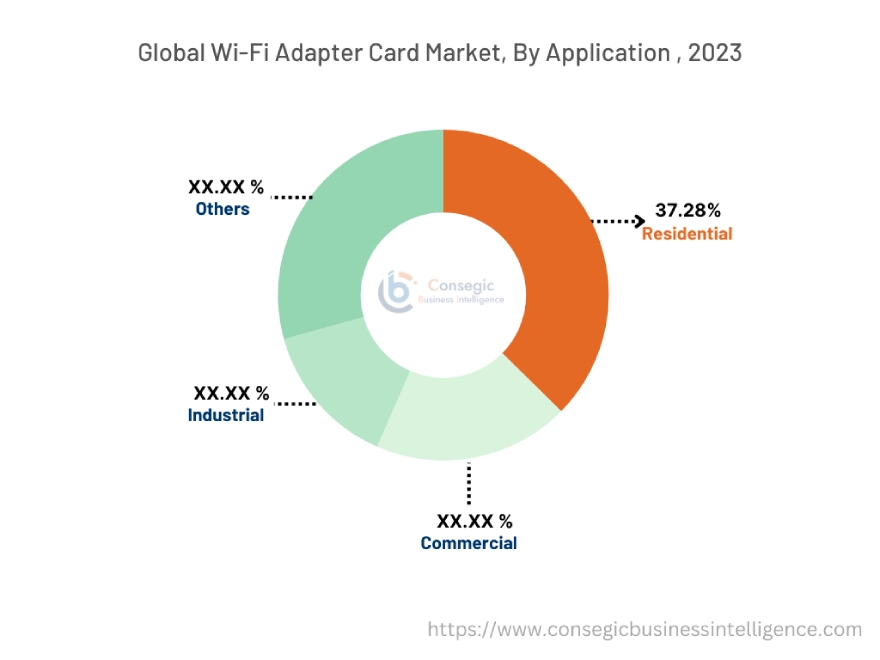
Regional Analysis:
The regions covered are North America, Europe, Asia Pacific, the Middle East and Africa, and Latin America.
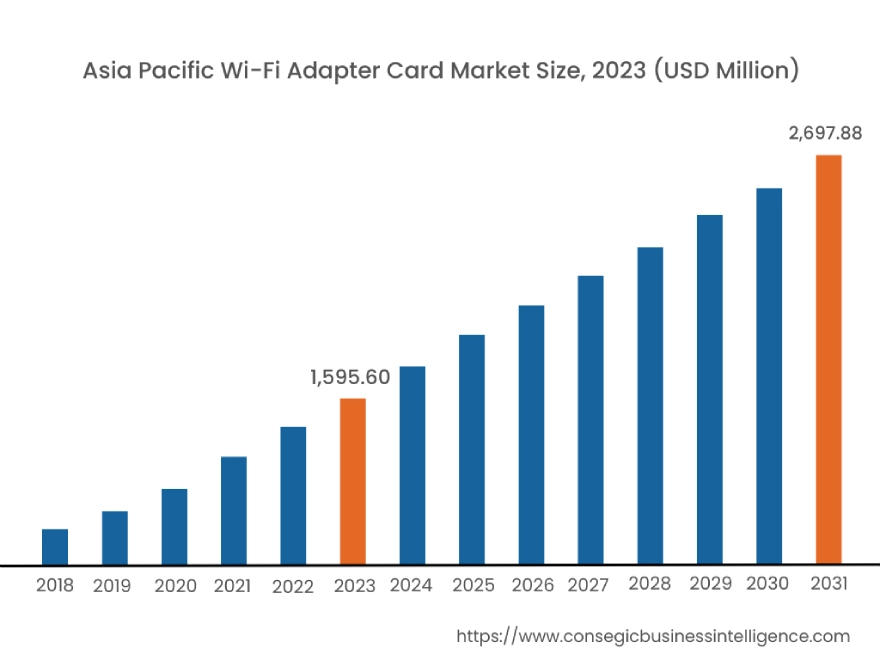
Asia Pacific region was valued at USD 1,595.60 Million in 2023. Moreover, it is projected to grow by USD 1,673.63 Million in 2024 and reach over USD 2,697.88 Million by 2031. Out of this, China accounted for the maximum revenue share of 33.1%. According to the Wi-Fi adapter card market analysis, the region is experiencing rapid growth in the Wi-Fi adapter card market driven by increasing urbanization, expanding internet penetration, and rising digitalization across the region. Additionally, incorporating Internet of Things (IoT) devices, smart devices, home automation devices, and others, with advanced Wi-Fi 6, Wi-Fi 6E, and Wi-Fi 7 technologies are propelling the industry.
In June 2022, Samsung launched Galaxy XCover6 Pro, a smartphone featuring Wi-Fi 6E connectivity and a 120 Hz refresh rate. It enhances wireless performance by providing faster speeds and better network efficiency.
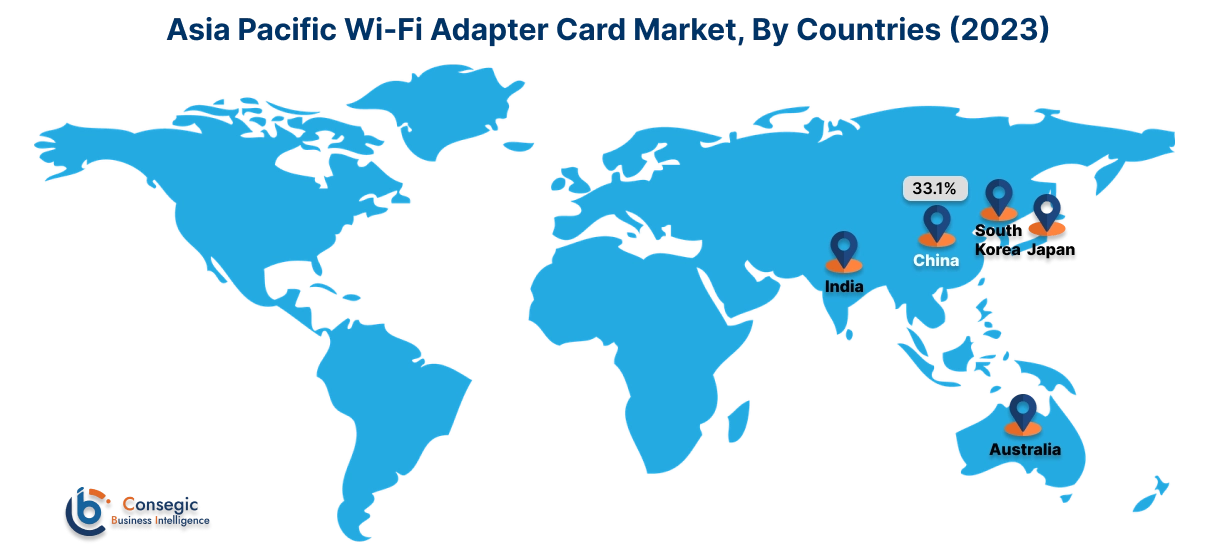
North America is estimated to reach over USD 3,441.61 Million by 2031 from a value of USD 2,097.15 Million in 2023 and is projected to grow by USD 2,194.19 Million in 2024. North America is leading the Wi-Fi adapter card market due to advanced technology infrastructure, high adoption rates, and strong consumer demand for high-speed internet. Additionally, the region is often at the forefront of adopting cutting-edge technologies including Wi-Fi 6, Wi-Fi 6E, and Wi-Fi 7, for control over automation systems, smart homes, security systems, and commercial applications.
- In October 2022, Google (US) introduced the Nest Wi-Fi Pro featuring Wi-Fi 6E technology. It offers an enhanced performance by utilizing the 6 GHz band, which provides faster speed, lower latency, and reduced interference. It is designed to improve connectivity and support devices simultaneously catering to high-demand internet applications.
In Europe, the Wi-Fi adapter card market is fueled by the increased adoption of advanced technologies supported by digital infrastructure. The enhanced connectivity is driving the deployment of high-performance adapters.
In Latin America, the Middle East, and Africa, the Wi-Fi adapter card market is growing as increasing internet penetration and digitalization drive the need for reliable and high-speed connectivity.
Top Key Players & Market Share Insights:
The Wi-Fi adapter card market is highly competitive with major players providing wireless connection to the national and international markets. Key players are adopting several strategies in research and development (R&D), product innovation, and end-user launches to hold a strong position in the Wi-Fi adapter card market. Key players in the Wi-Fi adapter card industry include-
- Intel Corporation (US)
- Qualcomm Technologies (US)
- TP-Link Technologies Co. Ltd (China)
- ASUSTek Computer Inc. (Taiwan)
- Cisco Systems, Inc (US)
- Broadcom, Inc. (US)
- Netgear Inc.(US)
- Belkim International Inc. (US)
- D-Link Corporation (Taiwan)
- Linksys (US)
Recent Industry Developments :
Product Launches:
- In May 2023, Netgear introduced the FWi-Fi 6E Unlocked 5G Mobile Hotspot with mmWave Technology. This device offers enhanced connectivity with the latest Wi-Fi 6E standard and supports 5G networks including mmWave frequencies, providing users with ultra-fast internet speeds and improved performance.
- In March 2023, Netgear launched the NETGEAR Nighthawk RS700 Router, a Wi-Fi 7 router, It provides ultra-fast speeds, expanded capacity, and lower latency, addressing the increasing demands for high-performance networking.
Collaboration:
- In September 2023, EE and Qualcomm collaborated to roll out in-home hardware featuring Qualcomm's Wi-Fi 7 technology. This partnership aims to enhance home connectivity providing customers with faster speeds, greater capacity, and improved performance.
Wi-Fi Adapter Card Market Report Insights :
| Report Attributes | Report Details |
| Study Timeline | 2018-2031 |
| Market Size in 2031 | USD 10,534.46 Million |
| CAGR (2024-2031) | 6.4% |
| By Type |
|
| By Technology |
|
| By Speed |
|
| By Sales Channel |
|
| By Application |
|
| By Region |
|
| Key Players |
|
| North America | U.S. Canada Mexico |
| Europe | U.K. Germany France Spain Italy Russia Benelux Rest of Europe |
| APAC | China South Korea Japan India Australia ASEAN Rest of Asia-Pacific |
| Middle East and Africa | GCC Turkey South Africa Rest of MEA |
| LATAM | Brazil Argentina Chile Rest of LATAM |
| Report Coverage |
|
Key Questions Answered in the Report
How big is the Wi-Fi Adapter Card Market? +
The Wi-Fi Adapter Card Market size is estimated to reach over USD 10,534.46 Million by 2031 from a value of USD 6,390.51 Million in 2023 and is projected to grow by USD 6,688.70 Million in 2024, growing at a CAGR of 6.4% from 2024 to 2031.
What is the key market trend? +
Devices including smartphones, laptops, and smart home gadgets are being equipped with Wi-Fi 6, Wi-Fi 6E, and Wi-Fi 7, driving the demand for compatible adapters.
Who are the major players in the Wi-Fi Adapter Card Market? +
Key players in the Wi-Fi Adapter Card Market are Intel Corporation (US), Qualcomm Technologies (US), Broadcom, Inc. (US), TP-Link Technologies Co. Ltd (China), Netgear, Inc.(US), ASUSTek Computer Inc. (Taiwan), Cisco Systems, Inc. (US), Belkim International Inc. (US), D-Link Corporation (Taiwan), Linksys (US) and others.
Which region/country is anticipated to witness the highest CAGR during the forecast period, 2023-2031? +
Asia-Pacific is anticipated to register the fastest CAGR during the forecast period driven by increasing urbanization, expanding internet penetration, and rising digitalization across the region.
